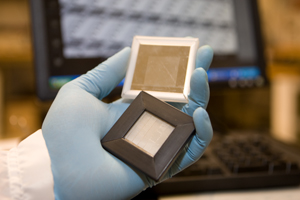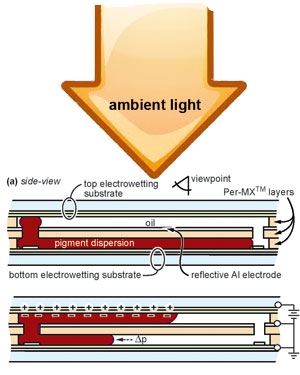Electrofluidics design to enable low-power color displays for e-readers and cell phones
October 6, 2010
A new “zero-power” electrofluidics design from the University of Cincinnati and partner companies Gamma Dynamics, Dupont, and Sun Chemical promises to dramatically improve the image capabilities of electronic devices such as e-readers and cell phones.
Currently, electronic devices fall into two basic camps. The first includes those devices that offer limited function and slow speed but require little power to operate. These include e-readers like the Kindle. In the second camp, devices like cell phones, laptops and the iPad provide high color saturation and high-speed capability for video and other functions, but at the cost of high-power usage.
How it works
Behind the new “zero-power” e-display screen are two layers of liquid (oil and a pigment dispersion fluid like an inkjet fluid). Between the two layers are reflective electrodes. Think of these electrodes as a highly reflective mirror.
Ambient light enters through the display screen and through the first layer of liquid and hits the reflective electrodes. When the light hits that reflective electrode, it bounces back out to the viewer’s eye, creating the perception of a bright, color-saturated image…or text or video… .
A small electric charge powers the movement of these oil and pigment-dispersion liquids. The movement occurs between a bottom layer behind the reflective electrodes and a top layer in front of the reflective electrodes. When the pigmented substance is positioned in the “top” layer (sandwiched between the ambient light and reflective electrodes), it creates a reflected ray of colored light which combines with literally millions of ambient light rays to produce a full-color display.
(The closest competition with similar brightness is electrochromic technology, which does not switch quickly enough to create video images. And the closest competition that is really low power but can still “do” video is called “Mirasol” technology developed by Quallcomm. However, when trying to display a color like white, the “Mirasol” technology has about one-third the brightness level of the UC technology being announced today. “Mirasol,” in fact, resembles grayed newsprint.)
Impact on e-readers, cell phones, and tablets
According to John Rudolph, president of Gamma Dynamics, this electrofluidics breakthrough will enable e-readers like the Amazon Kindle to display color and video, and devices like cell phones and the tablets will require much less power and will be readable even in bright sunlight. He estimated consumers will likely first see it in action as grocery-store shelf labels and advertising displays in about three years.
Partial support was also provided by grants from the National Science Foundation, the Army Research Laboratory, and the Air Force Research Laboratory.
Reference: Oct. 4 issue of Applied Physics Letters.
More info: University of Cincinnati news

